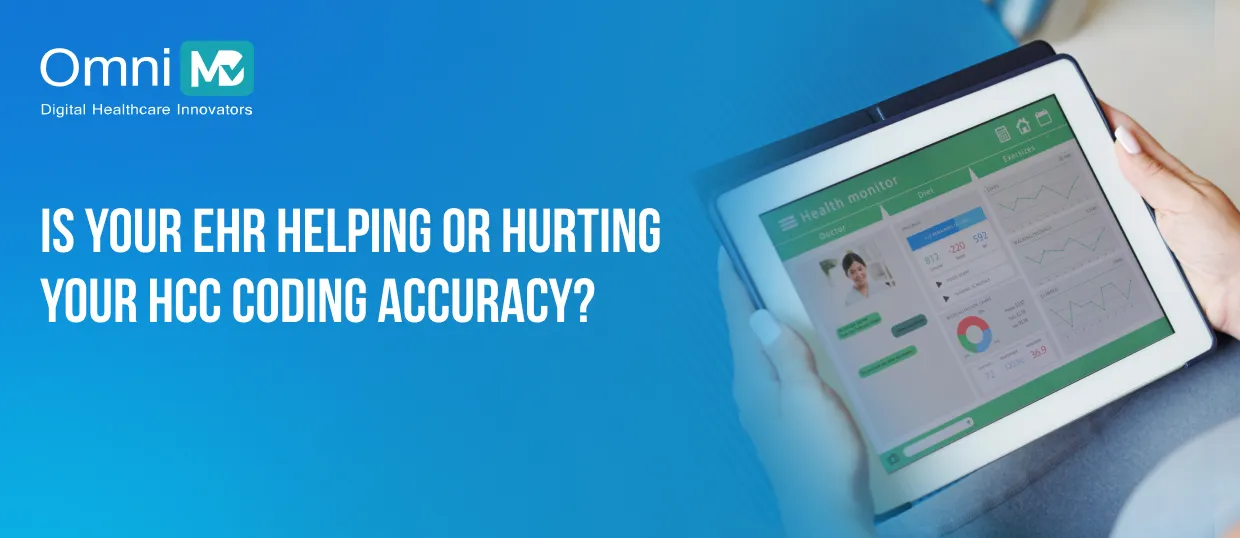Why HCC Coding Demands Our Attention in Primary Care
Primary care has been the cornerstone of patient-centered care, as there’s a transition from volume to value-based care. However, this shift brings a new reality that is even more complex than before, with an impact on patient outcomes and financial stability due to the complexities of clinical documentation and coding.
Unknowingly, many primary care providers are facing revenue leakage and compliance risks, not due to negligence but because their Electronic Health Record (EHR) systems don’t support accurate HCC coding. According to the National Association of ACOs, practices miss 8–12 HCC opportunities per 100 Medicare Advantage (MA) patients (source).
Let’s understand through a simple scenario: A 68-year-old patient with conditions like diabetes, hypertension, and early-stage chronic kidney disease visits your clinic. Ideally, in this condition, your EHR is supposed to prompt with correct diagnosis details and map the conditions to the active HCC category. However, your EHR fails to map the conditions to active HCC categories, resulting in underreporting of the patient’s actual risk. This one oversight would create a misleading risk profile and could result in thousands of dollars in annual reimbursement costs.
Similarly, another patient with Type 2 Diabetes (E11.9) qualifies for HCC 19. However, if they also have neuropathy (E11.40) or CKD Stage 3 (N18.3), those codes qualify for higher-weighted HCCs like 18 or 136. Failure to document those properly could lead to a RAF drop of 0.3-0.5, impacting thousands in reimbursement.
Thus, in this article, we’ll unpack what HCC coding really means for primary care, identify the risks associated with outdated or unsupported EHR systems, and demonstrate how advanced HCC-aware solutions can revolutionize the healthcare landscape, offering hope for improved financial and clinical outcomes
What is HCC Coding and Why Does It Matter in Primary Care
Hierarchical Condition Category (HCC) coding is a risk adjustment model developed by CMS to determine the expected future healthcare costs of patients. Risk adjustment is a process used to ensure that health plans and providers are compensated fairly for the health status of their patients. The HCC model uses diagnostic data to calculate a Risk Adjustment Factor (RAF) score, which directly influences Medicare Advantage reimbursements.
For primary care, this is particularly important. In contrast to single-system focused specialties, primary care caters to a broad array of chronic conditions, from diabetes and COPD to behavioural health and kidney disease. Capturing these intricacies through accurate HCC coding is essential not only for fair reimbursement but also for measuring care quality and ensuring regulatory compliance.
The Core Challenges in Primary Care That Make HCC Coding Difficult
As mentioned, primary care practices are on the front lines of managing chronic conditions, preventive care, and early detection. However, they face significant hurdles that directly impact the accuracy and completeness of HCC (Hierarchical Condition Category) coding, which in turn affects reimbursement, risk adjustment, and value-based care outcomes.
Let’s explore these challenges one by one with relevance.
1. Limited Time During Patient Visits
Primary care physicians often spend just 15–20 minutes per patient, during which they must review the patient’s chart, address immediate health concerns, discuss chronic conditions, educate the patient and document everything thoroughly.
However, this time crunch may lead to incomplete diagnosis documentation or inadequate chronic condition information, especially for those who are stable or not the reason for the visit.
To understand this, let us assume a patient with long-standing but stable diabetes and CKD comes in for throat infection treatment. Now, if the provider fails to re-document the current status of the diabetes and CKD, the patient’s HCC codes won’t be captured, leading to lower RAF (Risk Adjustment Factor) scores and underpayment.
2. Fragmented or Generic EHR Systems
CMS requires that every chronic condition be coded annually for accurate reimbursement. Yet, many providers who use an EHR without an innovative HCC dashboard may not receive an alert that a previously documented COPD diagnosis from last year wasn’t addressed this year. As a result, there is a delay in reimbursement and a lower RAF.
Most generic EHRs are not designed with HCC capture and risk adjustment in mind. They lack HCC-specific prompts or flags, don’t offer intelligent coding suggestions, and can’t auto-populate past chronic conditions that should be reviewed yearly.
3. Incomplete Problem Lists or Inconsistent Documentation
Over time, problem lists become out-of-date, chaotic, or inconsistently used. It becomes essential to structure the documentation and annual updates, so that the critical chronic conditions don’t fall through the cracks. Sometimes the conditions are listed in free text or missed entirely. The providers may assume ‘once coded, always counted’, which is not the case with HCC.
For example, conditions like Hypertension, diabetes, and obesity may be in the chart from two years ago. Still, if they aren’t actively addressed and coded in the current year with specificity like ‘Type 2 diabetes with neuropathy’, it would affect the reimbursement and risk profile as they won’t count toward the HCC model.
4. Absence of HCC Training for Providers and Coders
During residency or medical school, most primary care physicians were not trained in HCC coding principles. Additionally, coders may lack specific training in risk adjustment coding compared to fee-for-service CPT/ICD-10 coding.
This lack of training may lead to missing key diagnoses that need to be included, under coding (failing to use specific codes), and misunderstanding the qualifications for HCC.
Simply put, if a provider codes “CHF” for congestive heart failure without specifying “systolic” versus “diastolic” or documenting a recent discharge fraction, which is the reason to determine whether it qualifies as an HCC condition under CMS rules, it will affect the risk adjustment.
5. Reactive Coding Instead of Proactive Review
There are instances where many practices focus solely on coding the issues addressed during the current visit, rather than proactively reviewing the patient’s complete condition over the course of the year. This reactive approach fails to accurately capture all chronic illnesses that impact the patient’s health and care costs.
A patient with chronic asthma, diabetes, and depression comes in for a flu shot. Now, if the provider fails to review and reaffirm the previous condition codes and only mentions the code for the flu vaccine, those codes are lost for risk adjustment.
6. Lack of Standardized Process for Yearly HCC Review
Primary care practices often lack a structured, team-based workflow for reviewing and updating active conditions annually, retrieving previous years’ HCCs, and collaborating between clinicians and coders. This collaboration is facilitated by utilizing tools such as HCC scorecards, dashboards, or coding workflows.
Unless the process is defined, HCC coding becomes unreliable and reliant on memory or manual chart review.
To clarify, a patient’s prior year chart shows an HCC condition as rheumatoid arthritis with complications. This year, the MA plan asks for validation, but it’s missing from the new documentation. This may cause the reduced payment and audit risk for practice as that code is unrecoverable.
A Recap
| Challenge | Impact |
| Short visit times | Missed chronic diagnoses |
| EHR limitations | No HCC alerts or coding suggestions |
| Poor documentation habits | Incomplete problem lists |
| Lack of training | Under-coding or wrong coding |
| No team-based HCC workflow | Year-to-year gaps in coding |
| Reactive instead of proactive review | Lost reimbursement opportunities |
Where Generic EHRs Fail and Put Primary Care at Risk
Outdated or non-HCC aware EHRs contribute to a wide range of silent but serious problems:
1. No Real-Time HCC Suggestions
Most EHRs don’t prompt providers with potential HCCs during clinical documentation. This forces physicians to rely on memory or static cheat sheets, leading to missed opportunities.
2. Gaps in mapping Codes to Valid HCCs
Not all ICD codes map to HCCs. There is a dire need to intelligently map the codes with HCC, so that the providers may not enter diagnoses that don’t contribute to RAF, even though clinically relevant alternatives exist.
3. No RAF Visibility at Point-of-Care
Generic EHRs lack RAF visibility, resulting in a lack of RAF score tracking. Consequently, providers are unable to view the patient’s risk profile, which hinders proactive care planning and communication with the payer.
4. Missing Year-Over-Year Carry-Forward
Chronic conditions must be documented annually. If the EHR doesn’t remind providers of previously captured HCCs, conditions like COPD or CKD may go unreported.
5. Incomplete Grouping Alerts
EHRs need to prompt for completeness, as many HCCs depend on the specificity of conditions. For instance, it’s important to note additional complications like neuropathy, retinopathy, etc, along with coding diabetes, to lower the risk category. EHRs should prompt for completeness.
What Modern, HCC-Aware EHRs Can Do for Primary Care
The right EHR authorizes & empower the primary care providers to focus on care while supporting real-time risk documentation. Features include:
- As providers type notes or select diagnoses, the EHR system prompts real-time HCC suggestions. This ensures better reimbursement aligned with patient complexity, less coder intervention and reduction in revenue loss
- The primary care EHR automatically maps ICD-10 to HCC to confirm whether a code contributes to risk scoring. It helps providers achieve improved quality scores, avoid delays in treatment escalation, and support value-based care contracts.
- Providers can monitor risk scores in real-time (RAF score tracking), reducing charting fatigue and burnout, making room for meaningful patient conversation.
- The system guides note templates to ensure clinical support for every HCC assisting in Minimizing risk of recoupments during payer audits and protecting your primary care practice in compliance reviews
All you need is an EHR designed for primary care that doesn’t require your doctors to be coders.
The Way Forward
With the rising complexity and limited time, Primary care stands at the crossroads, where every clinical decision must also account for compliance, reimbursement accuracy and documentation. At this junction is where we need HCC-aware technology because the primary care providers need an intelligent EHR that is driven by real time HCC codes, monitors RAF scores, flags conditions that need annual recapture and ensures the audit ready documentation so that the outcome is far more than administrative efficiency. HCC aware EHR makes the primary care practices more sustainable, fair, and clinically sound care model. The Primary Care practices that embrace this shift are already seeing higher reimbursements that reflect their patient load, fewer denials, and greater confidence in value-based contracts. But here’s a deeper impact- a future where providers are not manual coding but focusing on medicine.
In today’s reality it is foundational and not optional, to code risk accurately. So gear up and ask yourself if you’re existing EHR holding you back or helping you move forward? If you’re a primary care looking to bridge the gap between the financial stability and clinical care, now is the time to act.
Essential HCC Abbreviations for Primary Care Documentation
| To effectively engage in HCC risk adjustment, every member of the care team should understand the following terms: |
|

HCC Coding Matters
Get paid right. Stay audit-ready.

 Written by Neha Singh
Written by Neha Singh
 Reviewed by Shivani Joshi
Reviewed by Shivani Joshi